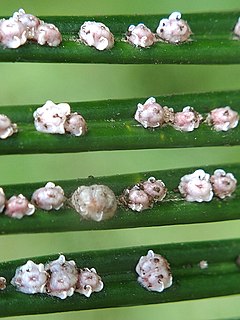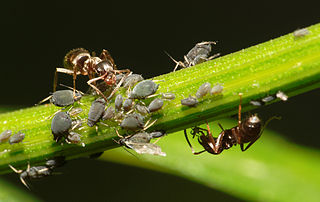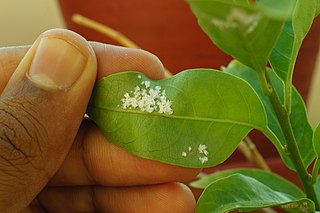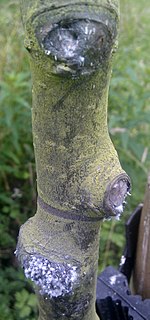Related Research Articles

Honey is a sweet, viscous food substance made by honey bees and some other bees. Bees produce honey from the sugary secretions of plants or from secretions of other insects, by regurgitation, enzymatic activity, and water evaporation. Honey bees store honey in wax structures called honeycombs, whereas stingless bees store honey in pots made of wax and resin. The variety of honey produced by honey bees is the best-known, due to its worldwide commercial production and human consumption. Honey is collected from wild bee colonies, or from hives of domesticated bees, a practice known as beekeeping or apiculture.

Aphids are small sap-sucking insects and members of the superfamily Aphidoidea. Common names include greenfly and blackfly, although individuals within a species can vary widely in color. The group includes the fluffy white woolly aphids. A typical life cycle involves flightless females giving live birth to female nymphs—who may also be already pregnant, an adaptation scientists call telescopic development—without the involvement of males. Maturing rapidly, females breed profusely so that the number of these insects multiplies quickly. Winged females may develop later in the season, allowing the insects to colonize new plants. In temperate regions, a phase of sexual reproduction occurs in the autumn, with the insects often overwintering as eggs.

Hemiptera is an order of insects, commonly called true bugs, comprising over 80,000 species within groups such as the cicadas, aphids, planthoppers, leafhoppers, bed bugs, and shield bugs. They range in size from 1 mm (0.04 in) to around 15 cm (6 in), and share a common arrangement of sucking mouthparts. The name "true bugs" is often limited to the suborder Heteroptera.

The yellow crazy ant(Anoplolepis gracilipes) is a species of ant, thought to have originated in West Africa, that has been accidentally introduced to numerous places in the world's tropics.

Scale insects are small insects of the order Hemiptera, suborder Sternorrhyncha. Of dramatically variable appearance and extreme sexual dimorphism, they comprise the infraorder Coccomorpha which is considered a more convenient grouping than the superfamily Coccoidea due to taxonomic uncertainties. Adult females typically have soft bodies and no limbs, and are concealed underneath domed scales, extruding quantities of wax for protection. Some species are hermaphroditic, with a combined ovotestis instead of separate ovaries and testes. Males, in the species where they occur, have legs and sometimes wings, and resemble small flies. Scale insects are herbivores, piercing plant tissues with their mouthparts and remaining in one place, feeding on sap. The excess fluid they imbibe is secreted as honeydew on which sooty mold tends to grow. The insects often have a mutualistic relationship with ants, which feed on the honeydew and protect them from predators. There are about 8,000 described species.

Protocooperation is where two species interact with each other beneficially; they have no need to interact with each other - they interact purely for the gain that they receive from doing this. It is not at all necessary for protocooperation to occur; growth and survival is possible in the absence of the interaction. The interaction that occurs can be between different kingdoms.

The Aphididae are a very large insect family in the aphid superfamily (Aphidoidea), of the order Hemiptera. These insects suck the sap from plant leaves. Several thousand species are placed in this family, many of which are considered plant/crop pests. They are the family of insects containing most plant virus vectors with the green peach aphid being one of the most prevalent and indiscriminate carriers.

Melezitose, also spelled melicitose, is a nonreducing trisaccharide sugar that is produced by many plant sap eating insects, including aphids such as Cinara pilicornis, by an enzyme reaction. This is beneficial to the insects, as it reduces the stress of osmosis by reducing their own water potential. The melezitose is part of the honeydew which acts as an attractant for ants and also as a food for bees. This is useful to the aphids as they have a symbiotic relationship with ants. Melezitose can be partially hydrolyzed to glucose and turanose the latter of which is an isomer of sucrose.

Woolly aphids are sap-sucking insects that produce a filamentous waxy white covering which resembles cotton or wool. The adults are winged and move to new locations where they lay egg masses. The nymphs often form large cottony masses on twigs, for protection from predators.

Tutu is a common name of Māori origin for plants in the genus Coriaria found in New Zealand.

Sooty mold is a collective term for different Ascomycete fungi, which includes many genera, commonly Cladosporium and Alternaria. It grows on plants and their fruit, but also environmental objects, like fences, garden furniture, stones, and even cars. The mold benefits from either a sugary exudate produced by the plant or fruit, or honeydew-secreting insects or sap suckers the plant may be infested by.

Honeydew is a sugar-rich sticky liquid, secreted by aphids and some scale insects as they feed on plant sap. When their mouthpart penetrates the phloem, the sugary, high-pressure liquid is forced out of the anus of the aphid. Honeydew is particularly common as a secretion in hemipteran insects and is often the basis for trophobiosis. Some caterpillars of Lycaenidae butterflies and some moths also produce honeydew.
Pine honey is a type of honeydew honey. It is a sweet and spicy honey, with some woody notes, a resinous fragrance and dark amber color. It is a common breakfast dish in Turkey and Greece, where it is drizzled over yoghurt and eaten with bread.

Myrmecophily is the term applied to positive interspecies associations between ants and a variety of other organisms, such as plants, other arthropods, and fungi. Myrmecophily refers to mutualistic associations with ants, though in its more general use, the term may also refer to commensal or even parasitic interactions.

The black bean aphid is a small black insect in the genus Aphis, with a broad, soft body, a member of the order Hemiptera. Other common names include blackfly, bean aphid, and beet leaf aphid. In the warmer months of the year, it is found in large numbers on the undersides of leaves and on the growing tips of host plants, including various agricultural crops and many wild and ornamental plants. Both winged and wingless forms exist, and at this time of year, they are all females. They suck sap from stems and leaves and cause distortion of the shoots, stunted plants, reduced yield, and spoiled crops. This aphid also acts as a vector for viruses that cause plant disease, and the honeydew it secretes may encourage the growth of sooty mould. It breeds profusely by live birth, but its numbers are kept in check, especially in the later part of the summer, by various predatory and parasitic insects. Ants feed on the honeydew it produces, and take active steps to remove the aphid's enemies. It is a widely distributed pest of agricultural crops and can be controlled by chemical or biological means. In the autumn, winged forms move to different host plants, where both males and females are produced. These mate and the females lay eggs which overwinter.

Chrysoperla carnea, one of the species of common green lacewing, is an insect in the Chrysopidae family. Although the adults feed on nectar, pollen and aphid honeydew, the larvae are active predators and feed on aphids and other small insects. It has been used in the biological control of insect pests on crops.

Doleromyrma darwiniana is a species of ant in the genus Doleromyrma. Described by Forel in 1907, the species is endemic to Australia and introduced to New Zealand, and it nests in soil or under stones and logs. The organism grows to a length between 2.0 and 3.0 millimeters. This species of ant maintains small colony sizes and it "prefers protein food." The species is also known by some sources as the "brown house ant" and "Darwin's ant". The species is considered a "minor urban pest" in New South Wales.
Cinara pilicornis, the spruce shoot aphid or brown spruce shoot aphid, is an aphid species in the genus Cinara found on Norway spruce and Sitka spruce. It is a quite large aphid species with a plump, dull brown body. It seems to have little effect on the tree. It is a European species but it has also been reported in spruce forests in New Zealand, together with the spruce aphid.

Eriosoma lanigerum, the woolly apple aphid, woolly aphid or American blight, is an aphid in the superfamily Aphidoidea in the order Hemiptera. It is a true bug and sucks sap from plants.
Paracletus cimiciformis is a species of aphid with a complex life cycle. Its primary host plant is Pistacia and its secondary host is a grass, where it is present on the roots. Here it is associated with an ant and part of its life cycle is spent in the ant's nest.
References
- Apidologie 33 (2002) 353–354 [ permanent dead link ] accessed Feb 2005
- Some Ohio Nectar and Pollen Producing Plants Dr. Jame E. Tew Ohio State University Extension Fact Sheet 1998; accessed Feb 2005
- New Zealand Honey; accessed May 2005
- All about honey; accessed Feb 2005
- New Zealand Honey accessed April 2007
- Spanish unifloral honeys; accessed Feb 2016
- accessed March 2016